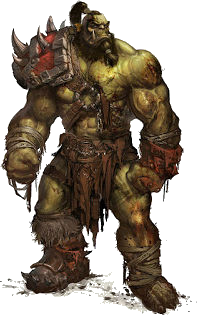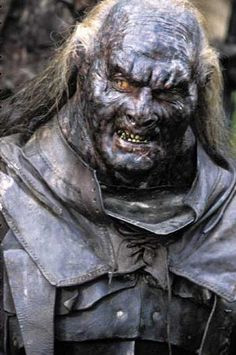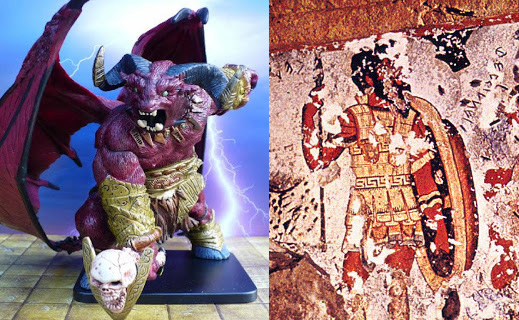 |
 WOW Styled Orc |
OrcIn Book #4, Dragon Eye, Sig, Rick, and Grampa Thor land in the middle of an Orc/Dwarf war while traveling the Wizard Express to the Sianchen glacier on border between India and Pakistan.
The first
popular appearance of Orcs was in Tolkein's Lord of the
Rings series. Tolkien's
work offers up a few different explanations for where orcs came from,
but the most popular one, the one featured in the live action films,
explains them as a corrupted, evil version of elves. The orc race is
seen as a mockery of the higher-minded races of Middle-earth, with
Saruman's monstrous Uruk-Hai possibly bei The
Rings movies depicted Orcs as somewhat human sized, but
with skin that appeared
to be the result of a bad wall spackling paste applied to cover up
their wounds, or to conceal lingering cases of acne. Poor dentition
will be a recurring theme. Orcs
are also positioned rather differently from their original Dungeons
& Dragons appearances. In contrast with the simian depiction
seen most frequently, the earliest drawings and depictions Orcs
apparently evolved enough that they became fit to star in the World of
Warcraft movie. Handsomer? That's a matter of opinion. A female Orc
would have a different
view than a California teenager. An orthodontist would see any, and all
Orcs as a beautiful payment on his/her
yacht.
If you keep tracing the term's history, through the French Mother Goose tales, back to the Italian stories that heavily influenced them, you can find what is likely the first appearance of the orc/ogre creature in the work of the Italian fairy tale collector Giambattista Basile. His monster, called huorco, huerco, or uerco, was a massive, tusked beast, which, in its various appearances, ran the gamut from cannibalistic to benevolent. The
original origins of the "orc"
Unlike
Hades, who was the ruler of the underworld, Orcus was specifically a
god of death, responsible for punishing evildoers in the afterlife. |
|
| Web Design by Mike Lance | |
 ng a result of orc and human crossbreeding.
ng a result of orc and human crossbreeding. of orcs in D&D were much more pig-like.
The creatures' fully elongated snouts were eventually shed, however,
though like most orcs, they maintained their porcine tusks. As for how
orc society is depicted in Dungeons
& Dragons—noble savages or just savages—much of that comes
down to the setting, the edition,
and the specific tribe.
of orcs in D&D were much more pig-like.
The creatures' fully elongated snouts were eventually shed, however,
though like most orcs, they maintained their porcine tusks. As for how
orc society is depicted in Dungeons
& Dragons—noble savages or just savages—much of that comes
down to the setting, the edition,
and the specific tribe. When you begin to examine the etymology of the
term orc, a fair amount of linguistic confusion arrives. In the 17th century, when the creatures first
made their way to England by way of fairy tales from continental
Europe, it was in the form "orke," which, at the time, was used
synonymously with "ogre." In the decades since, ogres have been
differentiated from orcs as larger creatures with more solitary social structures, but initially they were one in
the same—monstrous villains that populated continental fairy tales and
myths.
When you begin to examine the etymology of the
term orc, a fair amount of linguistic confusion arrives. In the 17th century, when the creatures first
made their way to England by way of fairy tales from continental
Europe, it was in the form "orke," which, at the time, was used
synonymously with "ogre." In the decades since, ogres have been
differentiated from orcs as larger creatures with more solitary social structures, but initially they were one in
the same—monstrous villains that populated continental fairy tales and
myths. term likely come from the Roman god of the underworld, Orcus, who
started out as the Etruscan god of the dead.
term likely come from the Roman god of the underworld, Orcus, who
started out as the Etruscan god of the dead.